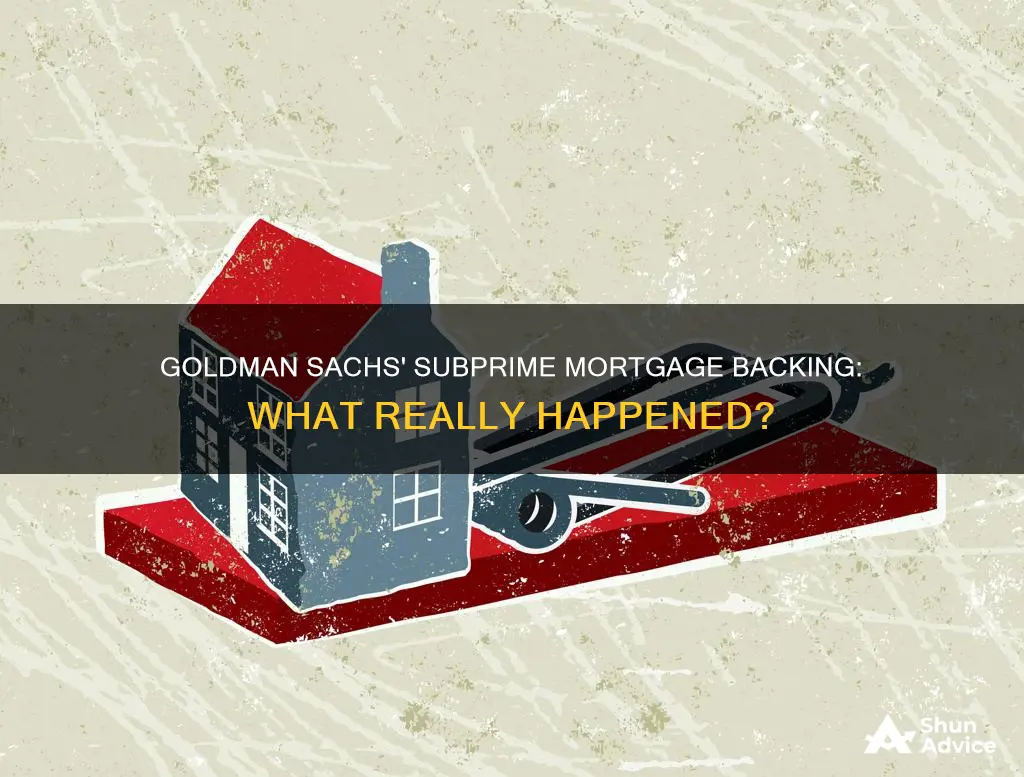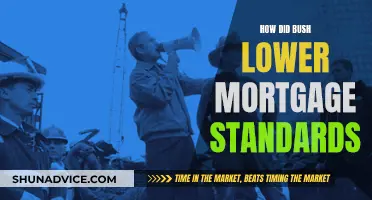
The role of Goldman Sachs in the subprime mortgage crisis has been a highly controversial topic, with the investment bank being accused of unethical practices and misleading investors. Unlike many investors and investment banks, Goldman Sachs anticipated the subprime mortgage crisis and developed mortgage-related securities to protect itself from investment losses. However, as the market began to collapse, Goldman Sachs profited from the defaults, pocketing huge sums and contributing to the financial crisis. This led to investigations and legal actions, including a $5 billion settlement with the Justice Department and a $550 million fine imposed by the Securities and Exchange Commission (SEC). The crisis highlighted the need for greater corporate responsibility and ethical conduct in the financial industry, as well as the importance of financial regulation and oversight.
| Characteristics | Values |
|---|---|
| Anticipation of the subprime mortgage crisis | Some traders at Goldman Sachs anticipated the crisis and developed mortgage-related securities to protect the company from investment losses. |
| Change in stance | In late 2006, Goldman Sachs changed its stance on the mortgage market from positive to negative. |
| Increased securities | As the market declined, Goldman Sachs created more securities to profit from mortgage defaults and bet against the market. |
| Profiting from the crisis | Goldman Sachs made billions of dollars by betting against the subprime mortgage market as it collapsed. |
| Misleading investors | Goldman Sachs was accused of misleading investors about the risks of its financial products, leading to investigations and lawsuits. |
| Regulatory response | The crisis led to regulatory reforms, including the Dodd-Frank Wall Street Reform and Consumer Protection Act, to increase transparency and accountability. |
| Ethical concerns | The crisis highlighted the need for greater corporate responsibility and ethical conduct in the financial industry. |
| Financial impact | Goldman Sachs received a $10 billion investment from the US Treasury as part of the 2008 financial bailout. |
| Legal consequences | In 2016, Goldman Sachs agreed to pay over $5 billion in connection with its sale of residential mortgage-backed securities. |
What You'll Learn

Investigations and legal actions
The subprime mortgage crisis, which was fuelled by risky lending practices and the creation of complex financial instruments, had a significant impact on Goldman Sachs' stakeholders, including employees, customers, and shareholders. The bank's involvement in the subprime mortgage market led to reputational damage and a loss of trust, with many stakeholders seeking compensation and assistance in the aftermath of the crisis.
Goldman Sachs has been the subject of several investigations and legal actions related to its role in the subprime mortgage crisis. Here is an overview:
- United States Congress and Department of Justice Investigations: Goldman Sachs was criticized for allegedly misleading investors and profiting from the collapse of the mortgage market, leading to investigations from the United States Congress and the Department of Justice.
- Lawsuits from Investors: Goldman Sachs faced lawsuits from investors who accused the bank of misleading them about its business practices and conflicts of interest ahead of the subprime mortgage crisis. While a U.S. appeals court ruled that shareholders could not proceed with a class-action lawsuit, individual investors have continued to pursue legal action.
- Securities and Exchange Commission (SEC) Charges: In April 2010, the SEC charged Goldman Sachs and one of its vice presidents, Fabrice Tourre, with securities fraud. The SEC alleged that Goldman misled buyers of a synthetic CDO, a type of investment, by not disclosing that a hedge fund that wanted to bet against the investment had played a significant role in selecting the underlying assets.
- Massachusetts Attorney General's Office Investigation: On May 10, 2009, Goldman Sachs agreed to pay up to $60 million to end an investigation by the Massachusetts Attorney General's Office. The investigation focused on whether the firm promoted unfair home loans in the state, leading to losses for investors.
- Other Lawsuits and Settlements: Goldman Sachs has been involved in several other lawsuits and settlements related to its business practices during the subprime mortgage crisis. For example, in 2003, Goldman Sachs, along with Lehman Brothers and Morgan Stanley, paid $3,380,000 to settle a lawsuit alleging they artificially inflated the stock price of RSL Communications.
- $5.06 Billion Settlement with the Justice Department: In 2016, Goldman Sachs reached a $5.06 billion settlement with the Justice Department and other federal and state partners. The settlement resolved claims related to Goldman's conduct in the packaging, securitization, marketing, sale, and issuance of residential mortgage-backed securities (RMBS) between 2005 and 2007. The settlement included a civil penalty, relief for distressed borrowers and affected communities, and payments to resolve claims by other federal and state entities.
Prepayment Penalties: Commercial Mortgage's Common Fine Print
You may want to see also

Misleading investors
The role played by Goldman Sachs in the subprime mortgage crisis led to numerous investigations and legal actions against the bank. During the 2007–2008 financial crisis, Goldman was criticized for allegedly misleading its investors and profiting from the collapse of the mortgage market. This led to investigations from the United States Congress, the United States Department of Justice, and a lawsuit from the U.S.
In April 2010, the U.S. Securities and Exchange Commission (SEC) charged Goldman Sachs and one of its vice-presidents, Fabrice Tourre, with securities fraud. The SEC alleged that Goldman had told buyers of a synthetic CDO that the underlying assets in the investment had been picked by an independent CDO manager, ACA Management. In fact, Paulson & Co., a hedge fund that wanted to bet against the investment, had played a significant role in the selection. The package of securities turned out to become one of the worst-performing mortgage deals of the housing crisis. The SEC's 2010 fraud suit charged Goldman with misleading investors with a synthetic CDO called Abacus 2007-AC1.
In 2011, a Senate panel released a report accusing Goldman Sachs of misleading clients and engaging in conflicts of interest. The United States Senate's Permanent Subcommittee on Investigations released a 635-page report entitled "Wall Street and the Financial Crisis: Anatomy of a Financial Collapse", which described some of the causes of the financial crisis. The report alleged that Goldman Sachs may have misled investors and profited from the collapse of the mortgage market at their expense.
In 2010, Goldman Sachs reached a settlement with the Securities and Exchange Commission (SEC), in which it agreed to pay a $550 million fine for misleading investors about the risks of a CDO that it had created and sold to investors. Goldman Sachs did not admit to any wrongdoing as part of the settlement.
In 2016, Goldman Sachs agreed to pay more than $5 billion in connection with its sale of residential mortgage-backed securities (RMBS). The Justice Department announced a $5.06 billion settlement with Goldman Sachs related to its conduct in the packaging, securitization, marketing, sale, and issuance of RMBS between 2005 and 2007. The resolution required Goldman to pay a civil penalty and provide relief to homeowners, borrowers, and affected communities.
The Subprime Mortgage Market: A Giant House of Cards
You may want to see also

Financial regulation and oversight
The role played by Goldman Sachs in the subprime mortgage crisis led to numerous investigations and legal actions against the bank. The crisis also led to regulatory reforms and highlighted the need for greater corporate responsibility and ethical conduct in the financial industry.
The Dodd-Frank Wall Street Reform and Consumer Protection Act was passed in 2010 in response to the financial crisis. The Act introduced a number of reforms to the financial industry, including increased transparency, stronger capital and liquidity requirements for financial institutions, and the creation of the Consumer Financial Protection Bureau (CFPB). The CFPB is responsible for protecting consumers from financial fraud and abuse.
The Volcker Rule enacted a de facto ban on proprietary trading by depository institutions, also decreasing the trading rights of proprietary traders at other large financial institutions. The Securities Act of 1933 was amended by Dodd-Frank to exempt some securities from registration and revise the definition of an accredited investor, removing the inclusion of a primary residence as part of an investor's net worth. Title IX of the Securities Exchange Act of 1934 requires the creation of an Investor Advisory Committee (IAC), an Office of the Investor Advocate (OIA), and an ombudsman appointed by the OIA to target conflicts of interest within investment firms.
The Investment Company Act of 1940 created new oversight committees and tighter restrictions on consumer protections and disclosure policies. The Investment Advisers Act of 1940 changed the registration requirements for investment advisors, affecting both independent investment advisors and hedge funds. The Sarbanes-Oxley Act of 2002 added new protections for whistleblowers and financial incentives.
In 2010, Goldman Sachs reached a settlement with the Securities and Exchange Commission (SEC), in which it agreed to pay a $550 million fine for misleading investors about the risks of a CDO that it had created and sold to investors. In 2016, the Justice Department, along with federal and state partners, announced a $5.06 billion settlement with Goldman Sachs related to its conduct in the packaging, securitization, marketing, sale, and issuance of residential mortgage-backed securities (RMBS) between 2005 and 2007.
Avoiding Another Subprime Mortgage Crisis: Lessons and Strategies
You may want to see also

Ethical standards
The 2008 financial crisis, which was caused by the collapse of the subprime mortgage market, brought to light ethical issues in the financial industry, particularly in relation to Goldman Sachs' practices. The crisis had far-reaching consequences, including severe economic downturns, job losses, and a loss of confidence in the banking industry.
Goldman Sachs, an investment bank, has long been criticized for its lack of ethical standards, including its close relationships with the US federal government and its involvement in driving up commodity prices through futures speculation. The bank has also been scrutinized for its role in the subprime mortgage crisis, where it profited from the collapse of the mortgage market while misleading its investors and contributing to significant financial losses.
During the crisis, Goldman Sachs sold residential mortgage-backed securities (RMBS) without adequately disclosing the true risks involved. These securities were backed by subprime mortgages that were likely to fail, and Goldman Sachs falsely assured investors that these securities were safe. As a result, investors suffered billions of dollars in losses, and Goldman Sachs was accused of contributing significantly to the financial crisis.
In response to the fallout from the 2008 financial crisis, Goldman Sachs took proactive measures to address the ethical and reputational challenges it faced. The bank established the Business Standards Committee (BSC), tasked with conducting a comprehensive review of its practices and implementing measures to enhance corporate accountability and client care. The BSC introduced policies to increase transparency, strengthen risk management practices, and develop a comprehensive code of ethics and conduct to foster a culture of integrity.
The BSC's efforts have been recognized for their commitment to transparency, ethical conduct, and client care, setting a precedent for the industry. Through these initiatives, Goldman Sachs has taken significant steps toward rebuilding trust and restoring its image as a responsible financial institution.
The Goldman Sachs subprime mortgage crisis highlights the importance of ethical conduct and corporate responsibility in the financial industry. It underscores the need for stricter regulations, increased transparency, and stronger capital and liquidity requirements for financial institutions to protect clients and maintain the integrity of the financial system.
Ruoff Mortgage Venue: Size, Capacity, and More
You may want to see also

Impact on the global economy
The subprime mortgage crisis of 2007–2010 was a significant event that had a profound impact on the global economy. It led to a severe economic recession, resulting in job losses and business bankruptcies. The crisis was caused by the expansion of mortgages to high-risk borrowers, coupled with rising house prices, which contributed to a period of turmoil in financial markets. This turmoil was further exacerbated by the collapse of the United States housing bubble and high-interest rates, which led to an unprecedented number of borrowers defaulting on their mortgage repayments.
Goldman Sachs, a prominent investment bank, played a significant role in the lead-up to the crisis. The bank has been criticised for its lack of ethical standards and for driving up commodity prices through futures speculation. Notably, Goldman Sachs was accused of misleading investors and profiting from the collapse of the mortgage market. Investigations revealed that Goldman Sachs had engaged in the packaging, securitisation, marketing, sale, and issuance of residential mortgage-backed securities (RMBS) between 2005 and 2007. The bank agreed to pay over $5 billion in settlements, with a significant portion allocated to providing relief to distressed borrowers and affected communities.
The impact of the crisis on the global economy was far-reaching. Firstly, it resulted in a credit crunch as banks became reluctant to lend to one another and to their customers, leading to a reduction in the overall availability of credit. Secondly, it caused a decline in construction activity as the demand for new housing decreased, which had a ripple effect on related industries and employment rates. Thirdly, the crisis led to a decrease in consumer spending as individuals tightened their budgets in the face of economic uncertainty. This further exacerbated the economic downturn, impacting businesses across various sectors.
The subprime mortgage crisis also highlighted the interconnectedness of the global financial system. As many banks and financial institutions held these high-risk mortgage-backed securities, the losses were widespread and significant. This crisis led to a loss of confidence in the financial industry, raising questions about the role and responsibilities of financial institutions and the need for stronger regulation and oversight.
The aftermath of the crisis saw the development and implementation of financial regulations and oversight mechanisms, such as the Dodd-Frank Wall Street Reform and Consumer Protection Act. These reforms aimed to increase transparency, strengthen capital and liquidity requirements for financial institutions, and protect consumers from financial fraud and abuse. The crisis also prompted a broader discussion about corporate responsibility and ethical conduct in the financial industry, including the role of executive compensation in incentivising risky behaviour.
MyFICO Scores: How Close to Mortgage Eligibility?
You may want to see also
Frequently asked questions
The Goldman Sachs subprime mortgage crisis was a major financial crisis that had significant consequences for the financial industry and the global economy. It was the result of the collapse of the subprime mortgage market, fueled by risky lending practices and the development of complex financial instruments.
The collapse of the subprime mortgage market was caused by a combination of factors, including risky lending practices, the use of complex financial instruments, and the interconnection between banks and financial institutions through the sale and purchase of securities.
Goldman Sachs was accused of misleading investors and profiting from the collapse of the subprime mortgage market. The company was also criticized for its lack of ethical standards and the impact its actions had on the global financial system.
The Goldman Sachs subprime mortgage crisis led to numerous investigations and legal actions against the bank. Goldman Sachs reached a settlement with the Securities and Exchange Commission (SEC) in 2010, agreeing to pay a $550 million fine for misleading investors. The company also faced other lawsuits and settlements, including a $5 billion settlement with the United States Department of Justice in 2016.
The lessons learned from the Goldman Sachs subprime mortgage crisis led to the development of financial regulations and oversight mechanisms, such as the Dodd-Frank Wall Street Reform and Consumer Protection Act passed in 2010. The Act introduced reforms such as increased transparency, stronger capital and liquidity requirements for financial institutions, and the creation of the Consumer Financial Protection Bureau.







